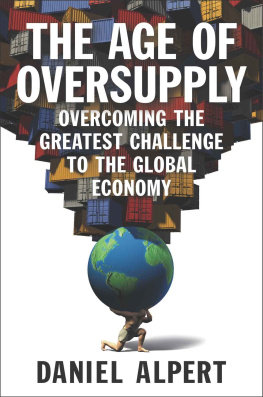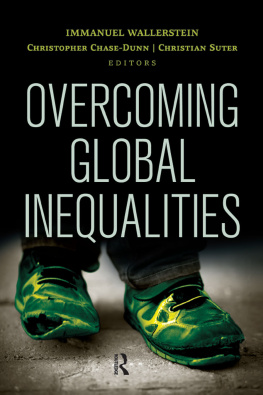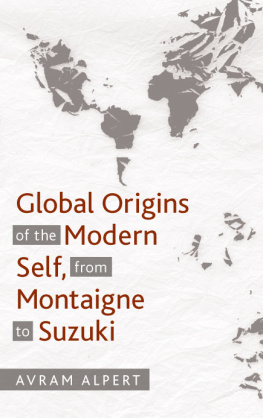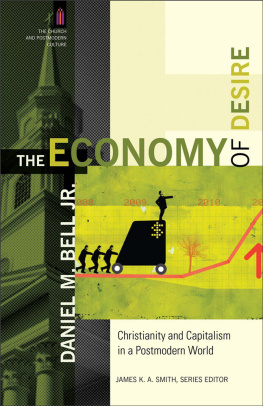Daniel Alpert - The Age of Oversupply: Overcoming the Greatest Challenge to the Global Economy
Here you can read online Daniel Alpert - The Age of Oversupply: Overcoming the Greatest Challenge to the Global Economy full text of the book (entire story) in english for free. Download pdf and epub, get meaning, cover and reviews about this ebook. year: 2013, publisher: Penguin Group US, genre: Politics. Description of the work, (preface) as well as reviews are available. Best literature library LitArk.com created for fans of good reading and offers a wide selection of genres:
Romance novel
Science fiction
Adventure
Detective
Science
History
Home and family
Prose
Art
Politics
Computer
Non-fiction
Religion
Business
Children
Humor
Choose a favorite category and find really read worthwhile books. Enjoy immersion in the world of imagination, feel the emotions of the characters or learn something new for yourself, make an fascinating discovery.
- Book:The Age of Oversupply: Overcoming the Greatest Challenge to the Global Economy
- Author:
- Publisher:Penguin Group US
- Genre:
- Year:2013
- Rating:5 / 5
- Favourites:Add to favourites
- Your mark:
- 100
- 1
- 2
- 3
- 4
- 5
The Age of Oversupply: Overcoming the Greatest Challenge to the Global Economy: summary, description and annotation
We offer to read an annotation, description, summary or preface (depends on what the author of the book "The Age of Oversupply: Overcoming the Greatest Challenge to the Global Economy" wrote himself). If you haven't found the necessary information about the book — write in the comments, we will try to find it.
Daniel Alpert: author's other books
Who wrote The Age of Oversupply: Overcoming the Greatest Challenge to the Global Economy? Find out the surname, the name of the author of the book and a list of all author's works by series.
The Age of Oversupply: Overcoming the Greatest Challenge to the Global Economy — read online for free the complete book (whole text) full work
Below is the text of the book, divided by pages. System saving the place of the last page read, allows you to conveniently read the book "The Age of Oversupply: Overcoming the Greatest Challenge to the Global Economy" online for free, without having to search again every time where you left off. Put a bookmark, and you can go to the page where you finished reading at any time.
Font size:
Interval:
Bookmark:

PORTFOLIO / PENGUIN
Published by the Penguin Group
Penguin Group (USA) Inc., 375 Hudson Street,
New York, New York 10014, USA

USA | Canada | UK | Ireland | Australia | New Zealand | India | SouthAfrica | China
Penguin Books Ltd, Registered Offices: 80 Strand, London WC2R 0RL, England
For more information about the Penguin Group visit penguin.com
Copyright Daniel Alpert, 2013
All rights reserved. No part of this book may be reproduced, scanned, or distributed in any printed or electronic form without permission. Please do not participate in or encourage piracy of copyrighted materials in violation of the authors rights. Purchase only authorized editions.
ISBN 978-1-101-60163-1
To Arlene and Gerald Alpert, who taught me what I most needed to know, and to George, Hollis, Owen, and Charles, who will need to know more than I can teach them.

THE ENDLESS SLUMP
T he past twenty years have seen a transformation of the global economy unlike any ever witnessed.
In the time it takes to raise a child and pack her off to college, the world order that existed in the early 1990s has disappeared. Some three billion people who once lived in sleepy or sclerotic statist economies are now part of the global economy. Many compete directly with workers in the United States, Europe, and Japan in a world bound together by lightning-fast communications. Countries that were once poor now find themselves with huge surpluses of wealth. And the rich countries of the world, while still rich, struggle with monumental levels of debtboth private and publicand unsettling questions about whether they can compete globally.
This shift is hardly news. Starting a dozen or so years ago, we began to hear all about globalization and the economic threat that the new, flat world poses to developed countries. Yet since 2008, that talk has been overshadowed by the financial crisis and its aftermatha crisis that eviscerated trillions of dollars in household wealth, created near-record levels of unemployment, and left the United States and Europe in adverse economic straits that persist to the present day (joining Japan, which has been hobbled for two decades). The causes of the crisis, it was said, lay in too much risk taking by the lords of finance, along with too big an appetite for debt among ordinary people. And so for the past five years, weve heard less about China and India and more about how to fix the financial systems and economies of the developed countries.
When people think about todays economic challenges, many of them put the problems facing the United States and Europe in separate baskets: one basket for such thorny issues as how to jump-start growth, reduce unemployment, and control the national debt; and a second basket for how to deal with trade deficits, currency issues, and competitiveness writ large.
This book argues that all these challenges belong in one basket. You cant understand the housing bubble and the financial crisis without appreciating how the rise of the emerging nations distorted the economies of rich countries. And you cant chart a course to more growth and stability in the developed world without recognizing that many of these distorting forces are still at work.
In the pages ahead, I argue that the central challenge facing the global economy is an oversupply of labor, productive capacity, and capital relative to the demand for all three.
Beginning in the late 1990s, a tidal wave of cheap money began flooding the global economy, much of it coming from Asia as China and other countries began to run huge trade surpluses and their burgeoning middle classes and thriving corporations socked away savings. Easy credit set the stage for the real estate bubble and the financial crisis. And cheap money also allowed Americans to sustain a high standard of living with low-cost borrowing and to ignore their declining competitiveness amid a growing surplus of global labor. Of course, the party couldnt last forever.
Yet five years after the financial crisis, many leaders and commentators in the United States and Europe still dont get what happened. Nor do they seem to realize that the age of oversupply is here to stay and that oversupply is a central obstacle to restarting growth. Many of the standard tools for fueling growth simply dont work. As I show in the pages ahead, cheaper credit through monetary easing doesnt yield much in an era when cheap capital already exists in abundance. And policies that seek to stimulate growth run up against the fact that there is a huge oversupply of global labor and productive capacity. Meanwhile, major risks linger in the banking sectors of the United States and Europe, where reforms have not gone nearly far enough. Today, despite the painful lessons of recent years, the global financial system is anything but stable.
Finally, the United States and Europe face a huge overhang of unresolved private debt, a legacy of the credit bubbledebt on a scale no nation has ever before confronted. These debts hold back growth, but asset holdersmostly the bankshave been loath to write these debts off and take the hit they have to take. Few political leaders are ready to force a painful resolution of these debts. And across both the political and financial worlds, hopes abound that growth will resume, inflating the value of underwater assets and devaluing outstanding debt.
That is simply unlikely to happen anytime soon. Economic growth wont rebound in a sustained way until the developed countries confront deep systemic problems in their own economies and the new and profound distortions in the global economy. Even though three billion people and trillions of dollars in wealth have emerged on the world scene, most policy makers are still stuck in denial about the earth-shattering nature of this shift.
Can the United States and Europe get out of this mess? (And what about Japan, which has seemingly been unable to do so for decades?) I believe they can, and this book offers a road map for avoiding a future of economic stagnation and new crises.
We must begin by acknowledging how much everything has changed. Economic troubleshootersfrom presidents to central bankers to lawmakers to economistsneed a fresh playbook in the age of oversupply. In particular, monetary policyhistorically a critical tool for fighting economic downturnssimply doesnt have, in a world of easy money, the bite it once had. And while fiscal stimulus can help restart growth, I argue that developed nations need to try this approach on a much larger scale than ever before if we are to put the advanced nations huge surplus of workers back to work. I suggest major new investments that deal strategically with infrastructure and I detail how such investment would not only help restart growth but also lay the foundation for future prosperity.
At the same time, I propose an aggressive effort to clear away the crushing burden of unresolved debt that is a legacy of the credit bubble. This is a daunting political challenge, because it means taking on creditors who hold trillions in bad debt. But until our advanced economies can emerge from under debt overhang, strong growth will be impossible. The United States, the worlds largest economy, must also confront two major obstacles to its global competitiveness: runaway costs for higher education and health careand I suggest ways to confront these costs.
Font size:
Interval:
Bookmark:
Similar books «The Age of Oversupply: Overcoming the Greatest Challenge to the Global Economy»
Look at similar books to The Age of Oversupply: Overcoming the Greatest Challenge to the Global Economy. We have selected literature similar in name and meaning in the hope of providing readers with more options to find new, interesting, not yet read works.
Discussion, reviews of the book The Age of Oversupply: Overcoming the Greatest Challenge to the Global Economy and just readers' own opinions. Leave your comments, write what you think about the work, its meaning or the main characters. Specify what exactly you liked and what you didn't like, and why you think so.













